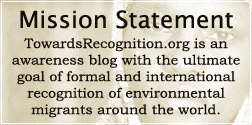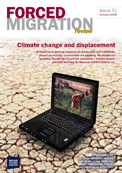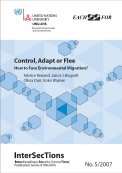(Up Front Blog) February 21, 2012 – There are many uncertainties around climate change-related human mobility, particularly when it comes to potential cross
-border movements. In the first place, it is difficult to predict the number
of people who will be displaced or who will decide to migrate for reasons related to climate change. And it is difficult to determine responsibility for caring for those who are displaced across borders. There are serious normative gaps which Nina Schrepfer and I [Walter Kalin] explored in a recent paper published in UNHCR’s legal and protection policy research series.
In our paper we present the background, context and present discussions around climate change-related mobility and then identify normative gaps for each of five scenarios of population mobility likely to occur:
- In the case of sudden-onset disasters, most of those displaced will remain within their own countries as internally displaced persons (IDPs) where an existing normative framework would apply: the Guiding Principles on Internal Displacement. But some may cross international borders– for example if this is the only escape route or there are no protection and assistance capacities at home. While movement is forced, these people generally do not fall under the criteria of international refugee law.
- In the case of environmental degradation and slow-onset disasters, cross-border movements are traditionally seen as migrants moving voluntarily as a way of coping with the changing environment. But with worsening environmental degradation, the movement of persons will become increasingly involuntary. In both cases, they have no right to admission and little protection except to a limited extent under general human rights law.
- For small island states facing threats because of rising sea levels, people will have to move to other islands belonging to the same state or cross international borders. Initially they will probably be part of a migratory movement but eventually their movement will be forced. International law does not provide
sufficient protection for them.
- The effects of climate change are likely to lead to zones prohibited for human habitation and it is likely that people will be relocated to other areas within the borders of their countries. But cross-border movements could occur if proposed relocation areas are unsuitable or if no durable alternatives in line with human rights standards are offered to the affected population. The character of this cross-border movement is unclear and will probably require individual determination as to whether such acts may amount to individual persecution under refugee law.
- Finally, if the effects of climate change lead to unrest, violence and armed conflict, those fleeing across a border may qualify as refugees under the 1951 Convention and related regional instruments.
In our paper, we explore the general obligations of states at the levels of mitigation, adaptation and protection. We identify critical legal issues which remain unaddressed, including the critical question of how to distinguish between voluntary and
forced movements and suggest ways to address these gaps. Finally, we suggest that a strategy is needed to create an international regime for the protection of people crossing borders in the context of climate change which is based on the four pillars of prevention, migration management, temporary and permanent protection schemes and resettlement.



